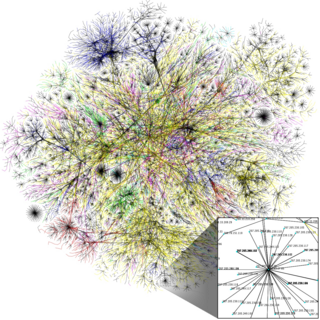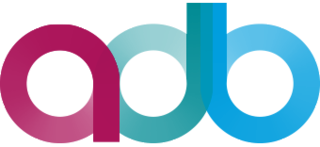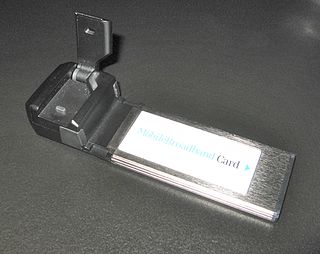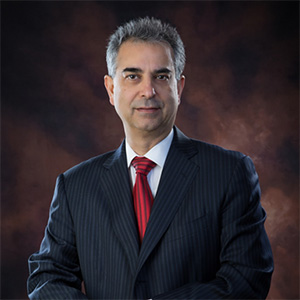 W
WThis article contains a sortable list of countries by number of broadband Internet subscriptions and penetration rates, using data compiled by the International Telecommunication Union.
 W
W10G-PON is a 2010 computer networking standard for data links, capable of delivering shared Internet access rates up to 10 Gbit/s over existing dark fiber. This is the ITU-T's next generation standard following on from GPON or Gigabit-capable PON. Optical fibre is shared by many subscribers in a network known as FTTx in a way that centralises most of the telecommunications equipment, often displacing copper phone lines that connect premises to the phone exchange. Passive optical network (PON) architecture has become a cost-effective way to meet performance demands in access networks, and sometimes also in large optical local networks for "Fibre-to-the-desk".
 W
WAdvanced Digital Broadcast (ADB) is a company which provides software, system and service solutions to pay-TV and telecommunication operators, content distributors and property owners around the world. The company specializes also in the development of digital connectivity devices such as set-top boxes and residential gateways.
 W
WThe Broadband Global Area Network (BGAN) is a global satellite network with telephony owned by Inmarsat using portable terminals. The terminals are normally used to connect a laptop computer to broadband Internet in remote locations, although as long as line-of-sight to the satellite exists, the terminal can be used anywhere. The value of BGAN terminals is that, unlike other satellite Internet services which require bulky and heavy satellite dishes to connect, a BGAN terminal is about the size of a laptop and thus can be carried easily. The network is provided by Inmarsat and uses three geostationary satellites called I-4 to provide almost global coverage.
 W
WBroadband mapping in the United States are efforts to describe geographically how Internet access service from telephone and cable TV companies is available in terms of available speed and price. Mapping has been done on the national as well as the state level. The efforts are seen as preliminary steps towards broadband universal service.
 W
WBSNL Broadband is an Indian Wireline Broadband Operator, is specialised division of Bharat Sanchar Nigam Limited which is under the ownership of Department of Telecommunications under Ministry of Communications of the Government of India. It provides both wired and wireless broadband services as well as many value added services. BSNL Broadband launched its services on 14 January 2005 as Data One.
 W
WThe BT Smart Hub is a family of wireless residential gateway router modems distributed by BT for use with their own products and services and those of wholesale resellers but not with other Internet services. Since v 5 Home/Smart Hubs support the faster Wi-Fi 802.11ac standard, in addition to the 802.11b/g/n standards. All models of the Home Hub prior to Home Hub 3 support VoIP Internet telephony via BT's Broadband Talk service, and are compatible with DECT telephone handsets. Since the Home Hub 4, all models have been dual band.
 W
WCaptive Audience: The Telecom Industry and Monopoly Power in the New Gilded Age is an American non-fiction book by the legal expert Susan P. Crawford. It describes high-speed internet access in the United States as essential but currently too slow and too expensive. To enable widespread quality of life and to ensure national competitiveness "most Americans should have access to reasonably priced 1-Gb symmetric fiber-to-the-home networks." Crawford explains why the United States should revise national policy to increase competition in a market currently dominated by Comcast, Verizon Communications, AT&T, and Time Warner Cable. Meanwhile, towns and cities should consider setting up local networks after the example of pioneers such as Lafayette, Louisiana's LUSFiber and Chattanooga, Tennessee's EPB.
 W
WChampion Broadband was a cable, Internet, and telephone provider in the United States. It previously operated in the Denver and Los Angeles markets along with smaller rural markets.
 W
WCincinnati Bell is a regional telecommunications service provider based in Cincinnati, Ohio, United States. It provides landline telephone, fiber-optic Internet, and IPTV services through its subsidiaries Cincinnati Bell Telephone and Hawaiian Telcom, which are the incumbent local exchange carriers for the Cincinnati and Dayton metropolitan areas and Hawaii. Other subsidiaries provide enterprise information technology services and long distance calling.
 W
WClearwire Corporation was a telecommunications operator which provided mobile and fixed wireless broadband communications services to retail and wholesale customers in the United States, Belgium, Ireland and Spain. Clearwire traces its roots to 1998, when Sierra Technologies, Inc., spun off certain assets to form a new company, Clearwire Technologies Inc. In October 2003, Craig McCaw purchased Clearwire Technologies, Inc. parent company Clearwire Holdings and moved the company headquarters to Kirkland, Washington. In 2012, Clearwire moved the company headquarters to Bellevue, Washington.
 W
WThe Community Broadband Network (CBN) is a British social enterprise which supports and develops community-led broadband initiatives.
 W
WDigital enhanced cordless telecommunications , usually known by the acronym DECT, is a standard primarily used for creating cordless telephone systems. It originated in Europe, where it is the universal standard, replacing earlier cordless phone standards, such as 900 MHz CT1 and CT2.
 W
WDigital Region, also stylised digital region, was a project in South Yorkshire set up to establish a high-speed next-generation 'Superfast Broadband' network in the specific region of northern England, first seeded in 2006, with 97% population coverage expected by the end of 2012. It was the first of its kind in the United Kingdom (UK). The project was co-ordinated by Digital Region Limited (DRL), owned by the Department for Business, Innovation & Skills (BIS), and the four local authorities that encompass South Yorkshire; these being Sheffield City Council, Barnsley Metropolitan Borough Council, Doncaster Metropolitan Borough Council, and Rotherham Metropolitan Borough Council. Thales Transport and Security was chosen to design, build and operate the project on behalf of Digital Region Limited, registered in England no: 5586340, registered office: Electric Works, Sheffield Digital Campus, Sheffield, S1 2BJ.
 W
WEPB of Chattanooga, formerly known as the Electric Power Board of Chattanooga, is an American electric power distribution and telecommunications company owned by the city of Chattanooga, Tennessee. EPB serves nearly 180,000 homes and businesses in a 600-square mile area in the greater Chattanooga area and Hamilton County. In 2010, EPB was the first company in the United States to offer 1 Gbit/s high-speed internet, over 200 times faster than the national average over a fiber optic network. As a result, Chattanooga has been called "Gig City®" and held up as a national model for deploying the world's fastest internet and America's most advanced Smart Grid electric distribution system. On October 15, 2015, Chattanooga implemented the world's first community-wide 10-gig Internet service, available to all homes and businesses in EPB's service area.
 W
WFiber to the x or fiber in the loop is a generic term for any broadband network architecture using optical fiber to provide all or part of the local loop used for last mile telecommunications. As fiber optic cables are able to carry much more data than copper cables, especially over long distances, copper telephone networks built in the 20th century are being replaced by fiber.
 W
WCincinnati Bell is a regional telecommunications service provider based in Cincinnati, Ohio, United States. It provides landline telephone, fiber-optic Internet, and IPTV services through its subsidiaries Cincinnati Bell Telephone and Hawaiian Telcom, which are the incumbent local exchange carriers for the Cincinnati and Dayton metropolitan areas and Hawaii. Other subsidiaries provide enterprise information technology services and long distance calling.
 W
WFritz!Box, stylised as FRITZ!Box, is a series of residential gateway devices produced by the German company AVM GmbH. In 2010 it was estimated the series had a market share of 68% of the digital subscriber line (DSL) consumer equipment in Germany.
 W
WFrontier FiberOptic is a bundled Internet access, telephone, and television service that operates over a fiber-optic communications network in California, Texas, Florida, Indiana, and South Carolina. Service is offered in some areas of the United States by Frontier Communications in areas built out and formerly served by Verizon, using the same infrastructure as its Fios service and continuing to license the FiOS name from Verizon. Other service providers often use fiber optics in the network backbone and existing copper or coax infrastructure for residential users. Frontier's service began in 2009 with the acquisition of portions of Verizon's network, and networked areas expanded through 2015 through similar acquisitions, although some areas do not have service or cannot receive TV and phone service because of franchise agreements.
 W
WGiganews, Inc is a Usenet/newsgroup service provider. Founded in 1994, Giganews service is available to individual users through a subscription model and as an outsourced service to internet service providers. Well-known ISPs that have outsourced Usenet access to Giganews include RCN Corporation, BT, WOW!, and Kingston Communications.
 W
WIEEE 802.20 or Mobile Broadband Wireless Access (MBWA) was a specification by the standard association of the Institute of Electrical and Electronics Engineers (IEEE) for mobile broadband networks. The main standard was published in 2008. MBWA is no longer being actively developed.
 W
WIntegrated Broadband Services (IBBS) provides fully integrated, cloud-based data and voice solutions to broadband providers in the United States, Canada, Latin America, the Caribbean, and Brazil. Serving over 250 broadband providers that support more than 1.5 million modems worldwide, IBBS provides both residential broadband services and commercial service solutions to broadband operators. IBBS also provides services in provisioning, diagnostics, engineering, development, network management, VoIP and technical support services.
 W
WInternet access is the ability of individuals and organizations to connect to the Internet using computer terminals, computers, and other devices; and to access services such as email and the World Wide Web. Internet access is sold by Internet service providers (ISPs) delivering connectivity at a wide range of data transfer rates via various networking technologies. Many organizations, including a growing number of municipal entities, also provide cost-free wireless access and landlines.
 W
WMobile broadband is the marketing term for wireless Internet access via mobile networks. Access to the network can be made through a portable modem, USB wireless modem, or a tablet/smartphone or other mobile device. The first wireless Internet access became available in 1991 as part of the second generation (2G) of mobile phone technology. Higher speeds became available in 2001 and 2006 as part of the third (3G) and fourth (4G) generations. In 2011, 90% of the world's population lived in areas with 2G coverage, while 45% lived in areas with 2G and 3G coverage. Mobile broadband uses the spectrum of 225 MHz to 3700 MHz.
 W
WBroadband is a term normally considered to be synonymous with a high-speed connection to the internet. Suitability for certain applications, or technically a certain quality of service, is often assumed. For instance, low round trip delay would normally be assumed to be well under 150ms and suitable for Voice over IP, online gaming, financial trading especially arbitrage, virtual private networks and other latency-sensitive applications. This would rule out satellite Internet as inherently high-latency. In some applications, utility-grade reliability or security are often also assumed or defined as requirements. There is no single definition of broadband and official plans may refer to any or none of these criteria.
 W
WNEXTV is a Canada-based Over the Top provider that delivers digital television services via Internet. It launched in 2007 and is owned by Ethnic Channels Group, a Canadian ethnic broadcaster. NEXTV offers an array of multicultural channels to subscribers, via a set-top box and high speed Internet connection. In 2012, Ethnic Channels Group acquired a BDU license for the Greater Toronto Area.
 W
WNG-PON2, Next-Generation Passive Optical Network 2 is a 2015 telecommunications network standard for a passive optical network (PON). The standard was developed by ITU and details an architecture capable of total network throughput of 40 Gbit/s, corresponding to up to 10 Gbit/s symmetric upstream/downstream speeds available at each subscriber.
 W
WNomad Digital is an Internet Protocol (IP) Connectivity provider to the transport sector. It deploys wireless broadband connections for trains, metros, trams and buses, including passenger Wi-Fi services and remote condition monitoring for on-board rail components. Headquartered in Newcastle upon Tyne in England, it operates globally.
 W
WA satellite dish is a dish-shaped type of parabolic antenna designed to receive or transmit information by radio waves to or from a communication satellite. The term most commonly means a dish which receives direct-broadcast satellite television from a direct broadcast satellite in geostationary orbit.
 W
WSES Broadband for Maritime is a two-way satellite broadband Internet service for use on private boats and commercial ships throughout European waters.
 W
WSo-net is a Japanese internet service provider operated by Sony Network Communications Inc. , a wholly owned subsidiary of Sony.
 W
WStandard-definition television is a television system which uses a resolution that is not considered to be either high or enhanced definition. SDTV and high-definition television (HDTV) are the two categories of display formats for digital television (DTV) transmissions. "Standard" refers to it being the prevailing specification for broadcast television in the mid- to late-20th century.
 W
WSwitched video or switched digital video (SDV), sometimes referred to as switched broadcast (SWB), is a telecommunications industry term for a network scheme for distributing digital video via a cable. Switched video sends the digital video in a more efficient manner so that additional uses may be made of the freed up bandwidth. The scheme applies to digital video distribution both on typical cable TV systems using QAM channels, or on IPTV systems. Users of analog video transmitted on the cable are unaffected. See diagram to the right for an illustration of how switched video saves bandwidth on a cable company's cables in the last mile where channels are transmitted via coaxial cable.
 W
WVerizon Communications Inc., commonly known as Verizon, is an American multinational telecommunications conglomerate and a corporate component of the Dow Jones Industrial Average. The company is headquartered at 1095 Avenue of the Americas in Midtown Manhattan, New York City, but is incorporated in Delaware.
 W
WVerizon Fios, also marketed as Fios by Verizon, is a bundled Internet access, telephone, and television service that operates over a fiber-optic communications network with over 5 million customers in nine U.S. states. The name, Fios, is an acronym for Fiber Optic Service. Service is offered in some areas of the United States by Verizon Communications, while Frontier Communications operates licensed FiOS services in former Verizon territories across six states, using a nearly identical network infrastructure. Fios service began in 2005, and networked areas expanded through 2010, although some areas do not have service or cannot receive TV and phone service because of franchise agreements.
 W
WVislink Technologies, Inc. is an American technology company that specializes in the collection, delivery, management and distribution of high quality live video and data. Founded as xG Technology in Sarasota, Florida in 2002, the company had acquired both Vislink and Integrated Microwave Technologies by 2017. In February 2019, xG Technology formally changed its name to Vislink Technologies. The company is headquartered in Hackettstown, New Jersey and has regional offices in Billerica, Massachusetts and Anaheim, California, as well as global offices in the United Kingdom, Dubai and Singapore. Vislink is a publicly traded company listed on the NASDAQ Capital Market.
 W
WWiBro is a wireless broadband Internet technology developed by the South Korean telecoms industry. WiBro is the South Korean service name for IEEE 802.16e international standard. By the end of 2012, the Korean Communications Commission intends to increase WiBro broadband connection speeds to 10Mbit/s, around ten times the 2009 speed, which will complement their 1Gbit/s fibre-optic network. The WiBro networks were shut down at the end of 2018.
 W
WWireless@SG is a wireless broadband programme developed by the Infocomm Development Authority (IDA) of Singapore as part of its Next Generation National Infocomm Infrastructure initiative, being part of the nation's 10-year masterplan called Intelligent Nation 2015 (iN2015).
 W
WWireless broadband is telecommunications technology that provides high-speed wireless Internet access or computer networking access over a wide area. The term comprises both fixed and mobile broadband.
 W
WRouzbeh Yassini, Ph.D., "Father of the Cable Modem", is an Iranian-American author, inventor, and engineer, who has gained an international reputation as a "broadband visionary" for his pioneering work in broadband industry and inventing the cable modem, establishing the cable modem industry standards (DOCSIS) through Cable Television Laboratories (CableLabs), the Society of Cable Telecommunications Engineers (SCTE) and the International Telecommunication Union (ITU). He is Executive Director of the University Of New Hampshire Broadband Center Of Excellence and Founder and Board Member of the YAS Foundation. Yassini is the author of “Planet Broadband”, a humanized look at broadband technology and its contributions to the society, as well as “Broadband Intelligent Series”, a series of white papers on digital services. He is a worldwide speaker and is often interviewed and quoted in the press for his vision on the future of broadband. His lifetime vision and dream is that all the people in the world have ubiquitous access to the broadband and be connected all the time. He believes that broadband connectivity is a fundamental right for all the human beings, what he has referred to it frequently as "Broadband Equality".